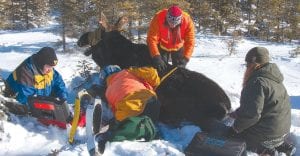A Minnesota Department of Natural Resources research team has been in Cook County for the last week, implementing the first phase of a multiple-year, $1.2 million project to try to determine why moose are dying at an unusually high rate in northeastern Minnesota. The research team is pictured here collaring and collecting samples from a cow. The extremely cold weather has made the work challenging.

The North Shore’s penchant for dishing out harsh winter weather hasn’t deterred Minnesota Department of Natural Resources (DNR) wildlife researchers from fitting high-tech GPS collars on 31 moose to help answer why Minnesota’s moose population continues to decline.
“We started the project last week near Grand Marais during a fourday stretch of extreme cold,” said Lou Cornicelli, DNR wildlife research manager. “Flight safety guidelines dictate no work can be performed below 20 degrees below zero. So despite the fact the helicopter was grounded for most of the first three days, we successfully collared and now are tracking nearly a third of the moose we plan to study.”
Capture and ground support crews wrestled with daytime wind chills that plummeted to as cold as 54 below zero on Jan. 21, and air temperatures that didn’t rise above zero until Jan. 24. “By this date when temperatures warmed, the helicopter capture crew was fully trained, allowing them to collar at least five to six moose a day,” said Erika Butler, DNR wildlife veterinarian.
Capturing and collaring adult moose is the first phase of a multiple year $1.2 million project to attempt to determine why moose are dying at unusually high rates in northeastern Minnesota. The DNR intends to put collars on 100 adult moose in the Grand Marais, Ely and Two Harbors areas in the weeks ahead as part of the most sophisticated moose research project ever conducted.
The DNR study is primarily about better understanding the causes of moose mortality. Annual population estimates show that Minnesota’s northeastern moose population has declined significantly since 2008. About 20 percent of adult moose die annually, although the exact causes of that mortality are not well understood. Previous research has demonstrated that hunting and predation by wolves are not the primary causes of adult deaths, and multiple signs indicate the causes are likely health- and stress-related factors.
Butler said that pending good weather and no serious operational problems, the DNR will be tracking 75 cow and 25 bull moose by mid-February.
Partners in the project include the University of Minnesota-Duluth, Fond du Lac Band of Lake Superior Chippewa, 1854 Treaty Authority (Bois Forte and Grand Portage Bands), the University of Tennessee, the Smithsonian, and the University of Minnesota.
A second phase of the project will examine moose calf mortality. After calving in spring, the locations of cows collared this winter will be used so their calves can be located, captured and fitted with collars that will provide data similar to that being collected from adults. Data from calves will provide much-needed information about calf survival and causes of mortality.


Loading Comments